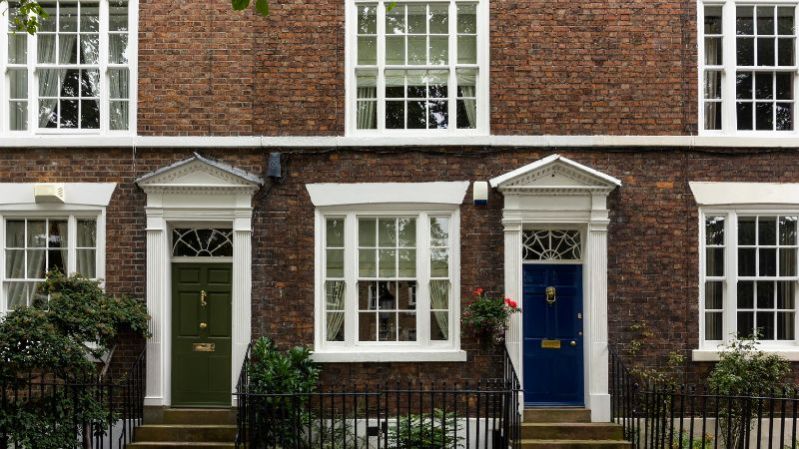At Clifton Private Finance, we’re experts at helping aspiring (and inspiring!) self-builders achieve the homes of their dreams with both immediate funding and long-term financial support.
Starting the Self-Build Journey: A Case Study
Asim and Zara made the decision to move from London to Carmarthenshire to build a sustainable three-bedroom home in the midst of the Covid pandemic.
With a re-evaluation of their life, they realised that they wanted to bring up any children they might have in a more rural setting, prioritising nature rather than the more frantic lifestyle of the city they had both grown up in. With jobs that enabled them to work from home, a new life seemed possible and as plans came together, the dream slowly became a realistic opportunity.
Involving Clifton Private Finance
Early in the process, Asim and Zara approached lenders to obtain a self-build mortgage. With confusing and often conflicting information, they turned to Clifton Private Finance to get a more holistic overview of the process and expert advice.
Our team were able to quickly help with some clear guidelines, including the fact that securing financing would require having a self-build warranty in place. We explained that without it, hidden structural defects could become a potential disaster in the future.
Understanding Why Self-Build Warranty Insurance is Important
Problems that can occur during construction don’t necessarily show themselves early on. Known as latent defects, these could occur because the design itself is at fault, because of poor workmanship in the construction, or because the materials themselves are substandard.
Asim and Zara discovered that self-build warranty insurance wasn’t merely a convenient option, but for many mortgage lenders it was an essential component that was needed to secure the mortgage. Without a self-build warranty in place, lender’s risk assessments were often too high to provide funding, and even for the few lenders that would consider providing the money Asim and Zara needed only offered deals with extremely high rates that would prove extremely costly in the long term.
Not only that, we explained that the warranty ensures the house maintains the maximum market value - important if they found themselves wanting to sell the house one it was finished. While they were both confident this wouldn’t be the case as they planned to life in the house for many years to come, they did agree that it was an important consideration.
With the pros of self-build warranty insurance clear, Asim and Zara were keen to obtain it:
- Necessary for securing the self-build mortgage.
- Ensures that if any latent defect occurs later on, there’s financial backing from the insurance to pay for repairs.
- Improves market value.
- Provides all-important peace of mind.
How Self-Build Warranty Insurance Works
A specialised form of structural warranty insurance, self-build warranty insurance is tailored around the needs of those working on their own home construction projects.
It is obtained in the early stages of the build project, before any construction work is done, with the insurers involved from the beginning in evaluating architectural plans and assessing the experience and professionalism of the prospective builders.
Throughout the building phase, regular inspections from qualified surveyors provide support and risk mitigation, ensuring that the work done is up to standards and meets regulations.
This involvement by the insurers is an added benefit for self-builders who are working with contractors to undertake the work, providing an additional line of professional inspection and assessment that increases confidence in the chosen building teams. Any issues discovered in these inspections can then be efficiently resolved early on, ensuring that when the home is finished, potential problems are minimised.
Once in place, self-build warranty insurance provides:
- 10-12 years of cover - The warranty lasts for the full first decade of a building’s use, by which time any defects due to construction are typically discovered.
- Risk mitigation for lenders - Not only for acquiring the self-build mortgage, having the warranty in place provides the needed guarantees for any future buyer to secure their own mortgages, or when leveraging the property for secured loans or remortgages.
- Peace of mind - Perhaps the most important consideration for many is the reassurance given by the warranty to the homeowners, who can sleep at night in their newly-created bedroom without the fear that something could occur that will wipe out their investment.
Meeting the Self-Build Warranty Insurance Requirements
With Clifton Private Finance team’s help, Asim and Zara make an early application for self-build warranty insurance. They provide detailed architectural and engineering plans for their home and collect together the credentials for their building contractors, including the main construction firm and their choice of carpenters and green live-roofing specialists.
With some unique architectural features, their glaziers are also an important team and the couple include those credentials and appropriate testimonials, even though they haven’t been directly requested. The package they provide the insurers is well thought out and comprehensive.
Asim and Zara are told they should inform the insurer at key stages of the project for inspection purposes. They do this in advance to allow the surveyor time for scheduling and to limit the number of delays.
Their 7 inspections are:

A Foundation Inspection
Prior to the concrete being poured for the foundation, the surveyor visits to inspect the site, taking particular notice of the excavation depth and condition, and the waterproofing installed to prevent damp.

Superstructure Inspection
Once the walls have been built up to the required level for the damp-proof course, the surveyor returns, primarily to look at the wall materials and consider the quality of the construction so far. Damp-proofing is a key consideration here. Having suffered from damp in previous rental accommodation, Zara is particularly keen to make sure the damp-proof course exceeds any standards.

Structural Framework Inspection
With the main structural framework of walls, beams, and all load-bearing elements is in place the surveyor schedules a third visit. He checks the building against the engineering drawings and tests the stability and integrity of the construction.

Roofing Inspection
Asim and Zara have opted for an ecologically responsible living roof; a slightly sloped roof on which grass and other vegetation will grow. Standards for green roofs are particularly high, so the inspection is detailed to ensure there is the correct level of support for the additional weight.
Additionally, the surveyor ensures that all ventilation and insulation is correctly installed as this will have a significant impact to condensation in the finished home. Energy conservation is another key aspect for the project, so the highest-grade insulation materials are used.

First-Fix Services Inspection
A fifth inspection concentrates on the electrical and plumbing systems threaded throughout the house. With the plasterwork yet to be done, the surveyor has access to fully check the standard of all the infrastructure and make sure regulations are met.

External Works Inspection
One of the final inspections is focused on the outside of the building, checking factors such as the brickwork and rendering, and checking all drainage for proper connections to waste extraction. In their rural setting, Asim and Zara have a cesspit system for sewerage which is inspected for efficiency and that it meets standards.

Pre-Completion Inspection
The final inspection occurs at the very end of the build. Once more the surveyor checks that the property meets all the pre-agreed warranty conditions and all legal compliances and standards.
With the pre-completion inspection signed off, the warranty begins and enters the defect liability period.
Considerations of New-Build Warranty Insurance
Understanding the Defect Liability Period
Insurers need to limit their risk to make new-build warranty insurance a viable product. One key way this is done is through the defect liability period. This is a period of one to two years during which the building team remains responsible for fixing any problems. Once the defect liability period has been passed, the warranty cover begins in full.
Transferring a New-Build Warranty
Unlike many home insurance products, a new build warranty is not tied to the person who obtained it, but is linked to the house. This means that should the house be sold, the warranty moves with it, giving the new homeowner the same protection moving forward.
The Difference Between New-Build Warranty Insurance and Standard Buildings Insurance
One potential confusion can arise over the similar-seeming nature of new-build insurance and home buildings insurance. Both are products that provide financial backup should something go wrong with the physical structure of the home - so what’s the difference?
There can be some crossover, such as with subsidence that can be construction-based (when the foundations are made of a substandard material, for example), or due to an external factor (when the ground shifts around the house). In these cases, and investigation by either insurance company will result in the correct insurance being applied.
New-Build Warranty Excess
Like most insurance policies, new-build warranty insurance will come with an excess. This may be tailored to different aspects of the warranty, with a different excess for design flaws to that for workmanship problems, for example.
The excess must be paid by the current property owner in all cases.
The Home-Build Journey: Exploring a Claim
Two years after moving in, Zara noticed damp creeping in the corner of the living room. After trying some simple but ineffective solutions, she and Asim decided to contact their warranty provider.
The couple were keen that this be fixed as soon as possible and moved to have repairs done immediately at a cost of £6,400. This cost was fully covered under their new-build warranty, although they still had to pay a £500 excess as detailed in their terms and conditions.
Asim and Zara were pleased. Not only was the problem analysed and confirmed quickly, and at no cost to them, but the warranty saved them almost £6,000 in this single instance. Without it, they would have been significantly out of pocket and would have struggled with such a dent in their finances - not to mention the associated worry and stress.
They returned to life as normal and the issue did not recur.
Protect Your Self-Build with Clifton Private Finance
Asim and Zara had a successful self-build with an efficient claim years later that fixed the problem smoothly; however, it could have been a story that ended badly without the warranty that underpinned their finances.
Without it, their dream of living in a unique and desirable three-bedroom home in South-West Wales would never have realistically come to pass.
If you are looking to have your own self-build story, contact Clifton Private Finance today and speak to one of our self-build experts who can help you get both the vital insurance and sizeable funding you need to achieve your perfect home.














